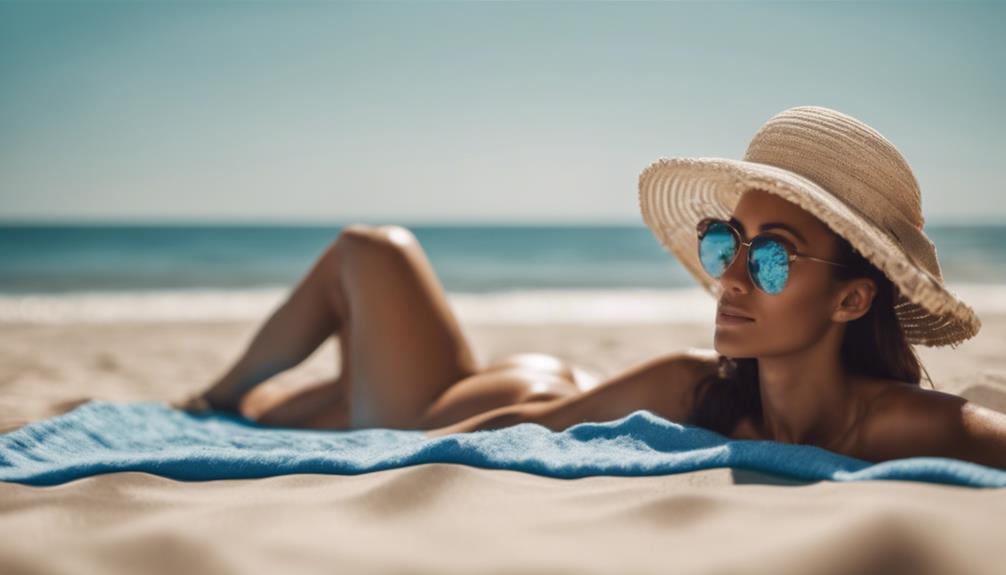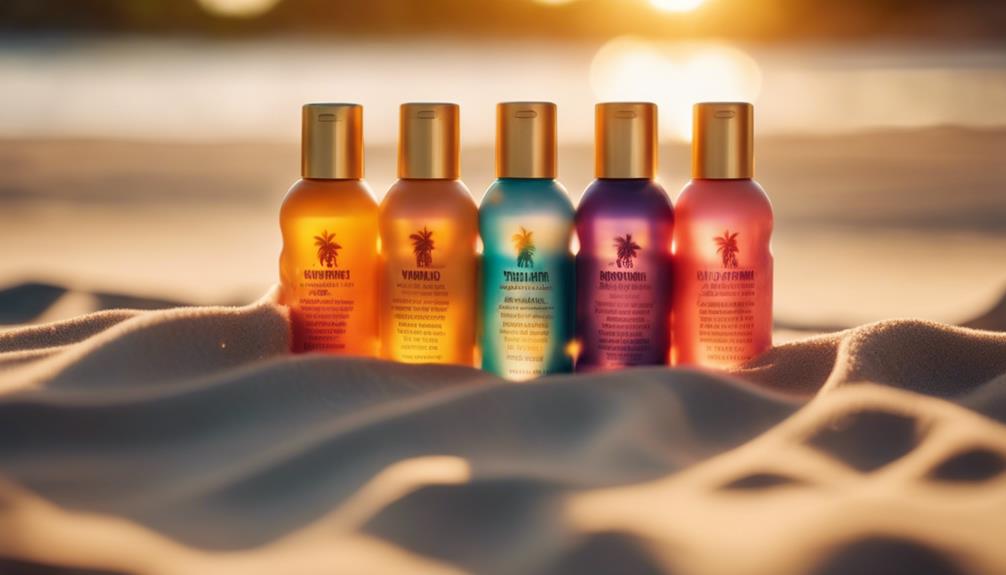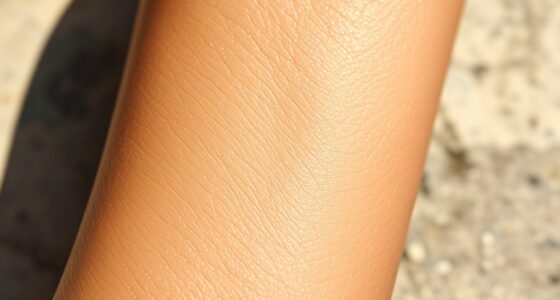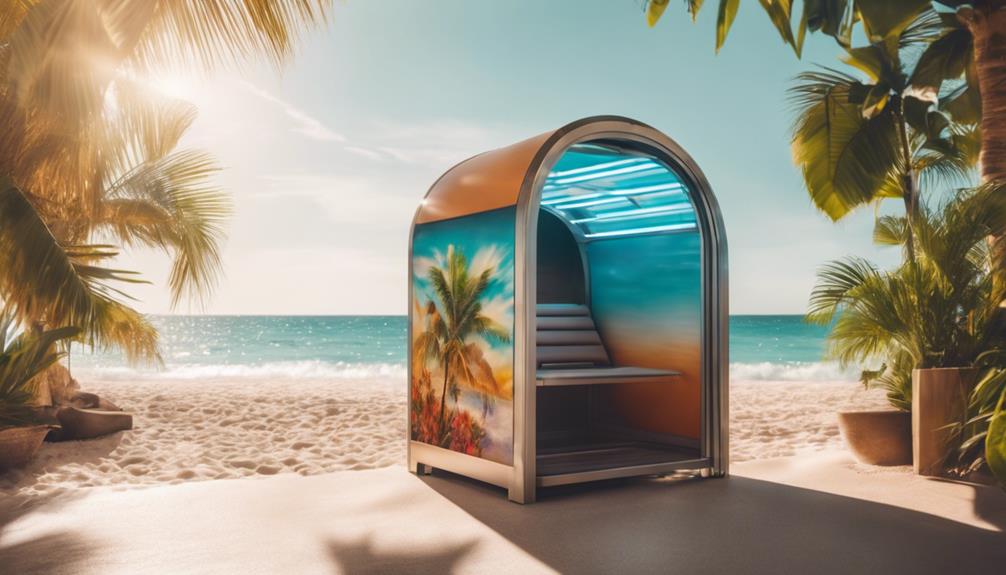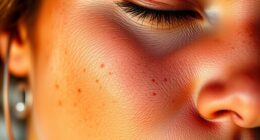When you're tanning, your eye safety should always come first! Make sure to wear high-quality protective goggles that fit snugly to block those sneaky UV rays, since closing your eyes isn't enough. It's like putting up a 'Do Not Enter' sign but leaving the door wide open! Limit your tanning sessions too—shorter times mean less UV exposure. And don't forget to rock some stylish sunglasses and use moisturizing eye drops afterward to keep your eyes happy! Trust me, keeping those peepers safe is essential, and there's so much more to discover about eye care for your tanning routine!
Key Takeaways
- Always wear high-quality protective goggles to shield your eyes from harmful UV rays during tanning sessions.
- Ensure goggles fit snugly to prevent slipping and block UV rays effectively.
- Limit tanning sessions and take breaks to reduce overall UV exposure and protect eye health.
- Use stylish sunglasses and moisturizing eye drops after tanning to soothe and protect your eyes.
Eye Protection Essentials
When tanning, always wear protective goggles to shield your eyes from harmful UV rays. Trust me, your eyes will thank you later!
Investing in high-quality goggles is a smart move, as cheap ones mightn't keep you safe. Look for goggles that fit snugly around your eyes—no one wants those pesky slips during a session. Keep an extra pair handy, just in case you forget yours. Many tanning salons provide spares, so don't sweat it!
After your tanning session, slip on some stylish sunglasses for extra protection, and don't forget the moisturizing eye drops to soothe those peepers.
Importance of Eye Safety

Wearing goggles isn't just a precaution; it's essential for protecting your eyes from the harmful effects of UV rays while tanning. Think of goggles as your eyes' best friends, shielding them from sneaky UV rays that can still get through closed eyelids. Remember, about 25% of UV radiation can reach your eyes, so it's no joke!
Here's a quick look at why eye safety matters:
| Risk | Consequence | Protection |
|---|---|---|
| UV Exposure | Eye damage | Wear goggles |
| Long-term Exposure | Serious eye issues | Invest in quality goggles |
| No Protection | Lasting vision problems | Always protect your eyes |
Proper Goggles Usage

Properly adjusting your goggles guarantees a snug fit that blocks out harmful UV rays while you tan.
Make sure to tighten those straps, so your goggles don't slip off like your favorite pair of socks in the dryer!
Check for any gaps where sneaky UV rays might sneak in; you want to protect your eyes, not give them a sunbath.
If you're feeling adventurous, consider using UV-blocking stickers for extra protection—think of them as your goggles' cool sidekick.
And remember, adjusting your goggles slightly can help avoid those pesky raccoon eyes.
So, gear up, smile, and enjoy your tanning session, knowing your eyes are safe and sound.
Your future self will thank you for it!
Limiting Tanning Sessions

Adjusting your goggles is just one part of protecting your eyes; limiting tanning sessions is equally important for maintaining eye health and preventing UV overexposure.
Think of it this way: your skin can get a sunburn, and your eyes can suffer too! By keeping your sessions short, you reduce the risk of serious eye damage.
So, stick to the recommended times and don't be tempted to go overboard—your peepers will thank you!
Plus, it's all about balance, right? Enjoy that golden glow, but remember to give your eyes a break, just like you'd give your skin a day off from the sun.
After tanning, don't forget those stylish sunglasses and soothing eye drops for extra comfort!
Common Misconceptions

Many people mistakenly believe that simply closing their eyes provides sufficient protection against harmful UV rays during tanning sessions. Unfortunately, that's a myth! Your eyelids don't block all UV rays, letting about 25% sneak through. This misunderstanding can lead to serious eye damage, so let's clear things up.
| Myth | Fact |
|---|---|
| Closing your eyes is enough. | Eyelids allow UV rays to penetrate. |
| Sunglasses are just as good. | You need specialized goggles for tanning. |
| Tanning is safe without goggles. | Goggles are essential for eye protection. |
| UV rays only affect skin. | They can cause serious eye issues too. |
| It's okay to skip eye protection. | Consistent protection is vital for safety. |
Best Practices for Tanning

Wearing protective goggles during every tanning session is essential for safeguarding your eyes from harmful UV rays. Trust me, you don't want to end up with raccoon eyes or worse—serious eye damage!
So, grab a pair of high-quality goggles that fit snugly; it's like a cozy hug for your eyes! Remember to limit your tanning sessions, too; shorter times mean less UV exposure, and that's a win-win.
After your session, rock those stylish sunglasses and keep some moisturizing eye drops handy to soothe your peepers. Staying informed about best practices for tanning can make all the difference in keeping your eyes safe while you soak up that sun-kissed glow.
Trending Topics in Tanning Safety

Staying updated on the latest trends in tanning safety can help guarantee you're protecting your eyes while achieving that desired glow. You'll want to check out the best practices and shiny new tips that pop up all the time. Here's a quick look at what's trending:
| Trending Topics | Why It Matters |
|---|---|
| UV-blocking stickers | Easy to use and stylish protection! |
| Shorter tanning sessions | Less UV exposure means happier eyes! |
| Quality goggle recommendations | Upgrading your goggles can make a big difference! |
| Spray tanning alternatives | Safer options for that sun-kissed look! |
| Eye health check-ups | Stay ahead of any potential issues! |
Frequently Asked Questions
Can I Use Regular Sunglasses Instead of Tanning Goggles?
You can't use regular sunglasses instead of tanning goggles. While they provide some UV protection, they often don't fit snugly or cover your eyes properly, leaving gaps that can expose your eyes to harmful rays.
Are There Specific Brands of Goggles Recommended for Tanning?
When it comes to tanning goggles, brands like EyeCandy and ProSun are popular choices. They're designed for ideal UV protection and comfort, ensuring your eyes stay safe while you soak up that sun-kissed glow.
How Often Should I Replace My Tanning Goggles?
You should replace your tanning goggles every six months or sooner if they show signs of wear or damage. Regularly check for scratches, and verify they still fit snugly for best protection during tanning sessions.
Do Uv-Blocking Stickers Work on All Types of Goggles?
Envision this: you're in a sci-fi movie, zapping away UV rays. UV-blocking stickers typically work on most goggles, but double-check compatibility. They enhance protection, so make sure your goggles have a smooth surface for best results.
What Should I Do if My Eyes Feel Irritated After Tanning?
If your eyes feel irritated after tanning, rinse them gently with cool water, apply moisturizing eye drops, and wear sunglasses outdoors. If irritation persists, consult an eye care professional for further advice.
Are Tanning Tips Also Important for Eye Safety?
When it comes to achieving the best tan, expert tips are crucial for ensuring overall safety, including for the eyes. Using protective eyewear and avoiding direct sunlight during peak hours are some of the best tan expert tips to safeguard your eyes from potential damage.
Conclusion
So, while it might seem like a hassle to wear goggles while tanning, think of it this way: you'd never jump into a pool without floaties, right?
Protecting your eyes is just as important! By following these tips, you can rock that sun-kissed glow without risking your vision.
Keep those peepers safe, and you'll enjoy beautiful skin and clear eyesight for years to come.
Now go out there, tan smart, and shine bright!
